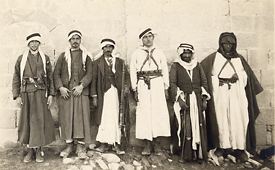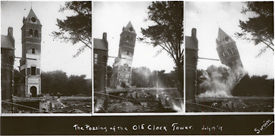Imagine Indiana Jones with a camera.
Hired as U-M’s first official photographer 100 years ago in 1913, George R. Swain rode the dusty back roads of the Middle East, Europe and Africa to document the work of U-M research expeditions. Back in Ann Arbor, he captured events, took photos to document the campus and to support lectures, and charmed readers with his expedition travels.


First U-M photographer George Swain’s subject matter ranged from Student Army Training Corps members drilling on campus in World War I to soldiers with the Judge Advocate General’s Office drilling in the Law Quad during World War II. In the top photo, a group of men in Lebanon stand for a photograph by George Swain, on expedition with Francis Kelsey for the university in the 1920s. Below, Swain depicts the razing of the clock tower on central campus in July 1917 through a series of photos. Photos courtesy Bentley Historical Library.
In “Notes and Comments of a Wolverine Abroad,” Swain recalled the Italian landscape on his way to a dig near Carthage:
“Were I to hazard a guess at its genesis, it would be that when the rest of Europe was made, the Fabricator Mundi made a few miscalculations in his specifications and came out with a plain or two, a lot of unmatched hills, and a few unwanted mountains and one huge volcano left over. Hoping to conceal his mistake, he hurled the whole lot of leftovers in a mass into the sea expecting them to sink in the Mediterranean, but they struck in shallow water — and later men called it Sicily.”
Swain served as university photographer for 34 years, until his death in 1947 at age 80. His expedition photos reveal excavation sites, artifacts and ornate treasures. Swain also made photographic records of valued manuscripts for the university’s collections.
The Bentley Library holds the George Robert Swain papers, which include writings, photographs and negatives. “They illustrate Swain’s keen eye for composition and offer a comprehensive coverage of the campus,” says Brian Williams, Bentley archivist.
Swain’s meticulous log described 13,344 photographs. “Unfortunately only a small percentage of his images survived. Swain himself is believed to have destroyed many of his negatives in a desire to keep only the best,” Williams says.
The educator
Swain’s first love was teaching. Born in New Hampshire in 1866, he traveled to California where he passed the teacher’s examination in 1888. Swain taught first in ungraded country schools and then at a high school in Ventura. One of his students was Edith Louise Rice, who would later become his wife.

Swain
Swain traveled to Michigan to earn his Bachelor of Arts degree from U-M in 1897 and master’s degree in 1900. That same year, the Swains married and briefly settled in Ann Arbor. But a few months later, Swain took a position as principal at East Side High School in Bay City, served until 1910, then accepted a similar post in Illinois from 1911-12.
In 1913 Swain returned to U-M. He began work on campus with Professor of Latin Francis W. Kelsey. Having previously traveled 2,000 miles in 1899 by bicycle through France, Switzerland, Belgium, Holland and Germany photographing Caesar’s battlefields, he was suited to accompany Kelsey on archeological expeditions in Europe as a photographic technician.
Swain’s campus photography actually predates his time as university photographer. He took photographs of U-M’s campus as an undergraduate in the 1890s. One of the earliest Swain photos at the Bentley is a glass negative from 1896 identified as “My Room at 94 E. Washington St. in Ann Arbor.” “In 1897 he wrote a fictional story ‘Because of a Kodak,’ which talked about developing photographic plates in the darkroom in the campus publication The Inlander,” Williams says.
But Swain’s standout work as official U-M photographer was for Kelsey. Swain produced magnificent documentation of the excavations, Williams says.
In 1924-25, Swain was part of a university expedition, which conducted excavations at Antioch. To get there, he and Kelsey drove from Brussels to Naples, then 300 miles across Asia Minor. Their Dodge truck and sedan, Swain wrote, were “heavily loaded with personal baggage, photographic apparatus and supplies, and camping equipment.” Swain describes freeing their vehicles from sticky mud, and times when the party “rolled ourselves in blankets by the roadside” when proper accommodations were lacking. These travels led to a photographic study of Roman aqueducts.
In 1925-26, Swain traveled to Italy, Greece, Mount Athos and Patmos. He worked with the Franco-American committee in Tunisia and Algeria and was permitted to photograph old manuscripts in 11 monasteries, eight of which were on Mount Athos. “On one trip he is reported to have exposed some 1,200 heavy glass plates, all of which were brought back for developing,” Williams says.
In letters, Swain talks of hauling 500 kilos of photographic apparatus and supplies about. “What is astounding is how difficult it was for Swain to conduct his work with Kelsey. Most of his photography was done on glass plate negatives which were very heavy and also extremely fragile,” Williams adds.
In a July 1925 letter, Swain describes taking many 8 x 10 pictures on Mount Athos and having to wait as the pictures “cannot be developed and prints made until my return to Ann Arbor in September.”
“In this age of instant digital photos, it is hard to imagine that Swain had to wait until he developed his glass plates to see how his photos turned out,” Williams says.
Back in Ann Arbor
As university photographer, Swain was allocated an office in the old campus library. There, he worked long hours to produce negatives for lantern slides used with lectures. Negatives were developed in his home darkroom at 1103 Packard, since the use of chemicals was forbidden in the library.
Outside of U-M, Swain and wife Edith directed a summer camp for girls, Kamp Kairphree near Alpena, and later at Lake Charlevoix. Swain also conducted a private photographic business. When the family traveled, he took his camera along. Back in Ann Arbor, he enjoyed photographing the campus and surrounding city and countryside.
“The time span of Swain’s campus photography is impressive, ranging from photos of members of the Student Army Training Corps drilling on campus in World War I to Judge Advocate General’s soldiers drilling in the Law Quad during World War II,” Williams says.
The public Bentley Image Bank (quod.lib.umich.edu/cgi/i/image/image-idx?c=bhl) features more than 100 digitized photographs by Swain.

